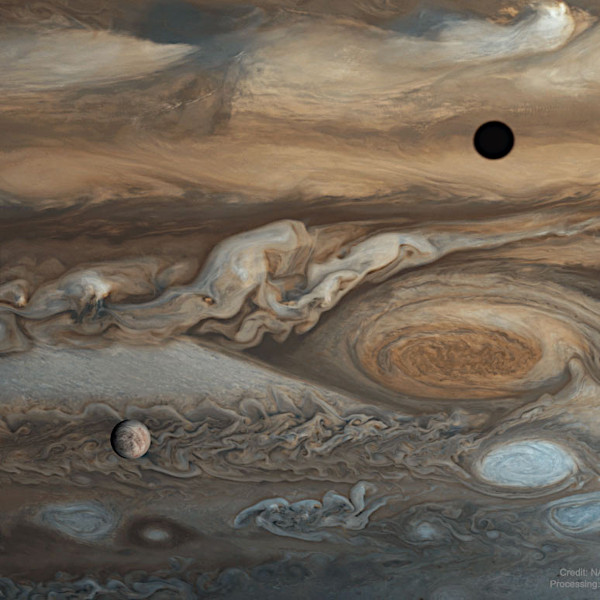
As of June 2025, the number of confirmed moons in the solar system exceeds 290 natural satellites. Jupiter and Saturn dominate this ranking with 95 and 146 moons recorded respectively, followed by Uranus (28), Neptune (16), Mars (2), and Earth (1). Mercury and Venus have none. Since the 2000s, automated observation campaigns have discovered a multitude of small moons, sometimes less than 1 km in diameter. Between 2017 and 2023 alone, more than 60 new moons were added to the catalogs, particularly around Jupiter and Saturn, thanks to the Subaru (Mauna Kea) and Magellan (Chile) telescopes.
Long considered inert objects, the moons of the solar system are now seen as dynamic, structured worlds, sometimes much more active than some planets. Their internal, atmospheric, or cryovolcanic activity often comes from gravitational resonances with their host planet, producing enough internal energy dissipation to maintain liquid environments, even very far from the Sun. These are now priority targets for the search for biosignatures and for future robotic exploration missions.
The discovery of subglacial oceans has revolutionized our understanding of the habitable zone. Enceladus (Saturn) is crossed by faults called "tiger stripes," from which cryogenic plumes rich in water, salts, and simple organic molecules gush. Europa (Jupiter) shows a tectonized surface with convective convection patterns in the ice, confirming the presence of a global ocean beneath a crust of 10 to 30 km. Ganymede, the largest moon in the solar system, would even have several liquid layers separated by high-pressure ice. These environments, rich in water and possibly locally heated, are potentially habitable.
No other moon matches Io (Jupiter) in terms of volcanism. More than 400 active volcanoes have been observed there, some of which project sulfur to more than 500 km in altitude. This intense volcanism is caused by strong thermal dissipation due to the 1:2:4 orbital resonance with Europa and Ganymede. Io's rigid crust is subjected to enormous tidal forces that generate internal friction, converting orbital energy into heat. The temperature of the lava lakes can exceed 1500 K. This extraterrestrial body offers a unique example of continuous geological activity outside Earth.
Some moons have developed a gaseous envelope, a rare phenomenon among satellites. Titan, enveloped in a dense nitrogen atmosphere (1.45 bar), is the only satellite with complete weather: winds, methane rains, lakes, and rivers of hydrocarbons. Triton (Neptune), retrograde and icy, has a tenuous atmosphere of nitrogen and methane, where nitrogen ice geysers are observed. Ganymede, although modest in atmospheric density, has an exosphere of molecular oxygen (\(\text{O}_2\)), generated by sputtering: the ejection of atoms by energetic particle bombardment. These atmospheres are valuable indicators of surface processes and interactions with magnetospheric plasma.
Ocean moons represent the best candidates for the search for extraterrestrial life. Three criteria are met there: presence of liquid water, internal energy, and organic chemistry. The Europa Clipper mission (NASA, launch planned for 2025) will analyze the ice thickness and the composition of Europa's possible plumes. JUICE (ESA, launched in 2023) will focus on Ganymede, Callisto, and Europa. As for Dragonfly (NASA), it will land on Titan around 2034 to explore its dunes and lakes. The common goal is clear: assess the habitability of these worlds, and perhaps detect prebiotic molecules or traces of primitive life in the ejecta or on the surface.
Among the approximately 290 moons recorded in the solar system, a few stand out for their impressive size, comparable to that of planets. The largest is Ganymede, a moon of Jupiter, with a diameter of 5268 km, larger than Mercury (4879 km). Following are Titan (Saturn, 5150 km), Callisto (Jupiter, 4820 km), Io (Jupiter, 3643 km), and Earth's Moon (3474 km). These giant moons are sometimes differentiated, with a metallic core, a silicate mantle, and an icy crust. They testify to a rich geological evolution, often marked by complex orbital resonances, lasting internal activity, and, for some, an atmosphere or a liquid ocean. Note also that Triton (Neptune), with its 2706 km, could be an ancient Kuiper belt object captured, explaining its retrograde orbit and cryovolcanic activity.
| Moons | Planets | Diameter |
| Ganymede | Jupiter | 5268 km |
| Titan | Saturn | 5150 km |
| Callisto | Jupiter | 4820 km |
| Io | Jupiter | 3643 km |
| Moon | Earth | 3474 km |
| Europa | Jupiter | 3122 km |
| Triton | Neptune | 2706 km |
| Titania | Uranus | 1578 km |
| Rhea | Saturn | 1528 km |
| Oberon | Uranus | 1523 km |
| Iapetus | Saturn | 1436 km |
| Umbriel | Uranus | 1169 km |
| Dione | Saturn | 1118 km |
| Thetys | Saturn | 1056 km |
| Ariel | Uranus | 1159 km |